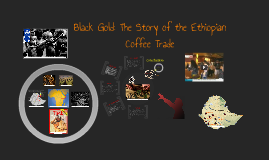Black Gold
Transcript: THE FUTURE is here... • The global coffee market is dominated by a mere four multinational corporations. - Kraft - Nestle - Proctor and Gamble - Sarah Lee •Coffee reaches the consumer after 6 chains of sellers and buyers. •Private traders are greedy. •Farmers are unable to negotiate prices with buyers. - They don't have frequent updates on price information - A select few control the market •Unlike the developed world, poor countries like Ethiopia don't have adequate funds to subsidize their farmers. - Therefore their crops can't compete in the world market. •The World Trade Origination (WTO) sets the regulations for global trade. - 148 countries meet for 5 days to make these rules. - The problems and concerns of underdeveloped countries are largely ignored. • Globally, more than 2 billion cups of coffee are drank daily. •Ethiopia is the largest producer of coffee in Africa. •The economy of whole communities is based on the price of coffee. • Over 15 million Ethiopians depend on coffee for their survival and it accounts for 67% of Ethiopia’s export revenue. • The supply of coffee on the world market was previously regulated by the International Coffee Agreement until its collapse in 1989. • Since 1989, the price farmers recieve for cofee has fallen to a 30 year low. http://ecadforum.com/wp-content/uploads/2011/08/ethiopia-famine-time-magazine1-226x300.jpg?d9c344 •If Ethiopia's share of world trade increased by 1%, it would generate 70 billion dollars which is 5 times more than they recieve in aid. • The primary strategy being utilized to improve the profits of farmers is that of eliminating the need for coffee suppliers, collectors, and middle-men. - Directly link the farmers through their own co-operative and through their union, directly to the roaster. •6o% of this costly 6 step processing chain is removed by working through co-operatives. - Ex: Oromia Coffee Farmers Co-operative Union •The consumers can make a difference in the market if they are more aware and demand more fair trade products. - Not just coffee, but all products from the third world which do not get a fair price. Goals •In Ethiopia, a cup of coffee costs 12 cents, in western countries it is sold for an average price of $2.90. - 80 cups of coffee are made from only one kilo of coffee. - A kilo of coffee is therefore worth $230. •Ethiopian farmers consider 23 cents for a kilo of coffee to be a good price. - They have yet to recieve a price of over $0.57. •Farmers need a 10 fold increase in profit to provide their families with nutritious food, clean water, clothes, and to be able to send their kids to school. - Need to receive $1.10 per kilo of coffee instead of $0.11 per kilo. •Some farmers aren't asking for a ten-fold increase in profit to be happy, most state that a price of $0.57 or 5 birr would "change their lives beyond recognition". http://lucyinnovation.files.wordpress.com/2011/04/fair_trade_coffee__hands_with_beans3.jpg • Africa is the only continent in the world to get more poor over the past twenty years. •Trade is more important to Ethiopia than aid. •7 million people in Ethiopia are dependent on emergency food aid every year. •Over the last 20 years, Africa’s share of world trade has dropped to 1%. • Instead of coffee, some farmers are growing chat (a narcotic smoked in East Africa) because it fetches a higher price. - Banned in most countries. • “It’s not just amazing how much bigger we are getting, but the lives that we are touching.” – Starbucks Manager - Sidama, the region in Ethiopia where Starbucks buys its coffee is suffering from famine. Black Gold: The Story of the Ethiopian Coffee Trade http://tesfanews.net/wp-content/uploads/2011/05/Ethiopia_Famine_undp-investigated.jpg - Pressure politicians to make responsible international trade rules that are fair to developing countries. - Ask companies to pay a fair price for their goods. - Buy fair trade items! Support the market for these products! - Donate to charities that will help subsidize Ethiopian communities and farms! - Inform others about the cause. http://bop.nppa.org/2007/thumbnails/512/00013140/INS/00013140-INS-Famine%20in%20Ethiopia-001.jpg Black Gold Conclusion: What YOU Can Do! Issues with the Market Prices http://www.keycoffeeroaster.com/images/samplefront.jpg http://www.nationsonline.org/map_small/ethiopia_africa.jpg http://growingalibrary.files.wordpress.com/2011/03/etmap2.gif The Facts http://www.afrol.com/images/release_photos/eth_malnutrition_fews.gif http://www.africanews.com/documents/6a/64/6a64bbb3a52e544f69558c1725cff36c.article.jpg

















